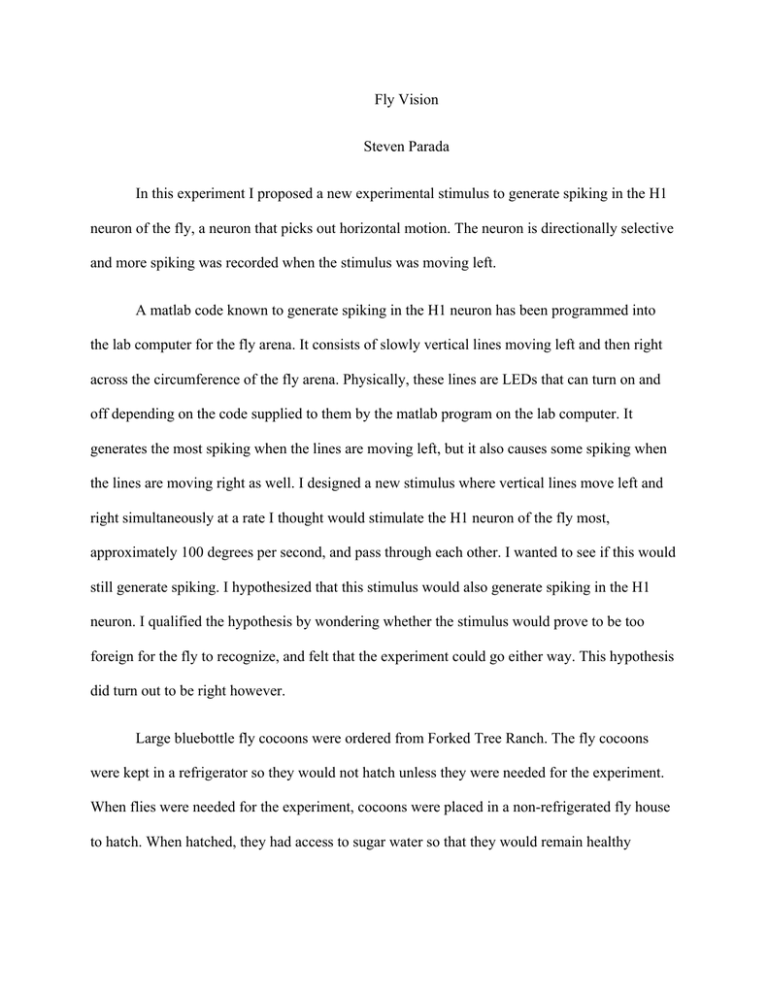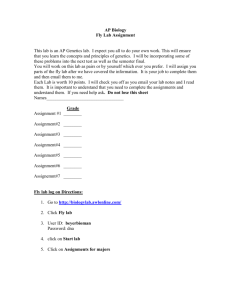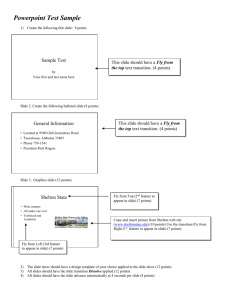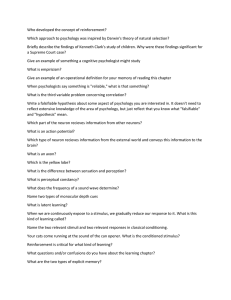Fly Vision Steven Parada
advertisement

Fly Vision Steven Parada In this experiment I proposed a new experimental stimulus to generate spiking in the H1 neuron of the fly, a neuron that picks out horizontal motion. The neuron is directionally selective and more spiking was recorded when the stimulus was moving left. A matlab code known to generate spiking in the H1 neuron has been programmed into the lab computer for the fly arena. It consists of slowly vertical lines moving left and then right across the circumference of the fly arena. Physically, these lines are LEDs that can turn on and off depending on the code supplied to them by the matlab program on the lab computer. It generates the most spiking when the lines are moving left, but it also causes some spiking when the lines are moving right as well. I designed a new stimulus where vertical lines move left and right simultaneously at a rate I thought would stimulate the H1 neuron of the fly most, approximately 100 degrees per second, and pass through each other. I wanted to see if this would still generate spiking. I hypothesized that this stimulus would also generate spiking in the H1 neuron. I qualified the hypothesis by wondering whether the stimulus would prove to be too foreign for the fly to recognize, and felt that the experiment could go either way. This hypothesis did turn out to be right however. Large bluebottle fly cocoons were ordered from Forked Tree Ranch. The fly cocoons were kept in a refrigerator so they would not hatch unless they were needed for the experiment. When flies were needed for the experiment, cocoons were placed in a non-refrigerated fly house to hatch. When hatched, they had access to sugar water so that they would remain healthy Necessary chemicals to keep the flies alive during the experiment were prepared. A bottle of this “fly saline” was prepared using chemicals available from the lab and the chemistry stockroom . The recipe for fly saline is 110 mM NaCl 5.4 mM KCl 1.9 mM CaCl2 20 mM NaHCO3 15 mM TRIS(base) 13.9 mM glucose 73.7 mM sucrose 23 mM fructose The lab and stockroom was out of fructose so I substituted equimolar glucose An important part of this experiment was using surgery to prepare the fly for experimentation. Flies needed for the experiment were captured from the fly house in a tube and anesthetized by placing the tube in the freezer. When anesthetized after about four minutes in the freezer the flies’ legs and wings were removed so that they would be suitable for fly surgery and experimentation and wouldn’t crawl or fly away.. Flies were waxed to a metal rod and their proboscis, or tongue was pulled out and glued to the other side so that the back of their heads would be exposed for surgery. A hole was cut in each fly’s head so that an electrode could be inserted to measure experimental data concerning H1 neuron spiking during the experiment To record spiking, an electrode connected to an oscilloscope and an audio accompaniment as well as the data acquisition computer, was inserted into the flies’ opened heads along with fly saline to keep them alive. The old and new stimuli were delivered to the fly placed in the flight arena The H1 neuron was found in these procedures, and two recordings with my new stimulus were made on a fly after the neuron was found using electrode adjustments and the old stimulus. Spiking was recorded in the old stimulus, and was more frequent when the stimulus was moving left than when it was moving right. Spiking was constantly recorded in my stimulus, where lines moved right and left simultaneously. The results of this experiment suggest that interfering with a left moving stimulus with other motion, here a right moving stimulus, still causes the H1 neuron to spike. There is still leftward motion recognition regardless of what is happening in addition. The data shows the voltage as a function of time, a green test spike assures that the data acquisition program is functioning properly. There are four data plots. A zoomed out old stimulus plot A zoomed in old stimulus plot, a zoomed out new stimulus plot, and a histogram of left moving and right moving spikes in the old stimulus. For the zoomed out data from the old stimulus, the stimulus is plotted over the data, where 1 signifies a left moving stimulus and -1 a right moving stimulus. Noise is plus or minus 0.1. The left moving histogram is above the right moving histogram.







